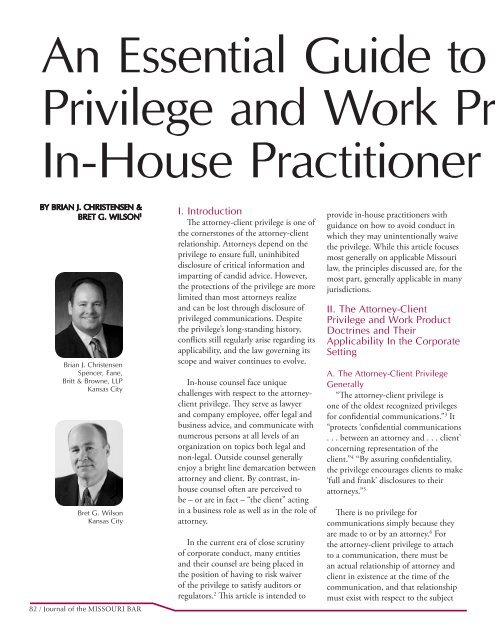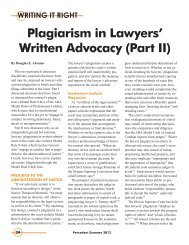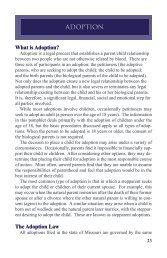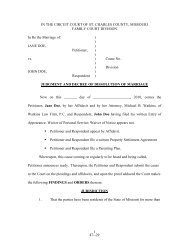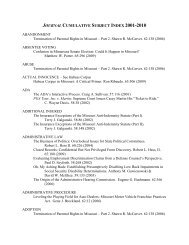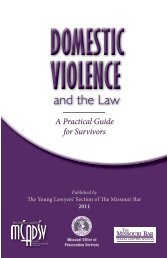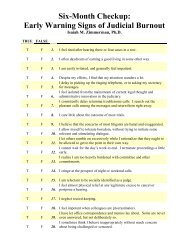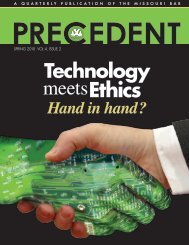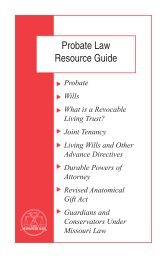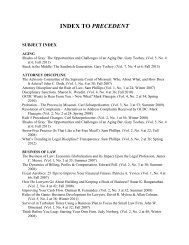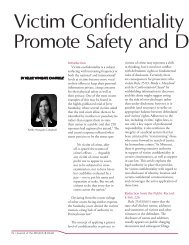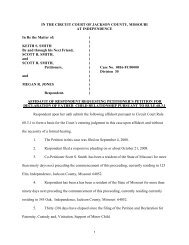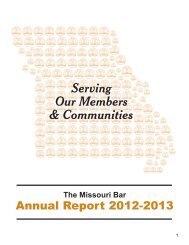An Essential Guide to Attorney-Client Privilege ... - the Missouri Bar
An Essential Guide to Attorney-Client Privilege ... - the Missouri Bar
An Essential Guide to Attorney-Client Privilege ... - the Missouri Bar
- No tags were found...
You also want an ePaper? Increase the reach of your titles
YUMPU automatically turns print PDFs into web optimized ePapers that Google loves.
<strong>An</strong> <strong>Essential</strong> <strong>Guide</strong> <strong>to</strong><strong>Privilege</strong> and Work ProIn-House PractitionerBY BRIAN J. CHRISTENSEN &BRET G. WILSON 1Brian J. ChristensenSpencer, Fane,Britt & Browne, LLPKansas CityBret G. WilsonKansas City82 / Journal of <strong>the</strong> MISSOURI BARI. IntroductionThe at<strong>to</strong>rney-client privilege is one of<strong>the</strong> corners<strong>to</strong>nes of <strong>the</strong> at<strong>to</strong>rney-clientrelationship. At<strong>to</strong>rneys depend on <strong>the</strong>privilege <strong>to</strong> ensure full, uninhibiteddisclosure of critical information andimparting of candid advice. However,<strong>the</strong> protections of <strong>the</strong> privilege are morelimited than most at<strong>to</strong>rneys realizeand can be lost through disclosure ofprivileged communications. Despite<strong>the</strong> privilege’s long-standing his<strong>to</strong>ry,conflicts still regularly arise regarding itsapplicability, and <strong>the</strong> law governing itsscope and waiver continues <strong>to</strong> evolve.In-house counsel face uniquechallenges with respect <strong>to</strong> <strong>the</strong> at<strong>to</strong>rneyclientprivilege. They serve as lawyerand company employee, offer legal andbusiness advice, and communicate withnumerous persons at all levels of anorganization on <strong>to</strong>pics both legal andnon-legal. Outside counsel generallyenjoy a bright line demarcation betweenat<strong>to</strong>rney and client. By contrast, inhousecounsel often are perceived <strong>to</strong>be – or are in fact – “<strong>the</strong> client” actingin a business role as well as in <strong>the</strong> role ofat<strong>to</strong>rney.In <strong>the</strong> current era of close scrutinyof corporate conduct, many entitiesand <strong>the</strong>ir counsel are being placed in<strong>the</strong> position of having <strong>to</strong> risk waiverof <strong>the</strong> privilege <strong>to</strong> satisfy audi<strong>to</strong>rs orregula<strong>to</strong>rs. 2 This article is intended <strong>to</strong>provide in-house practitioners withguidance on how <strong>to</strong> avoid conduct inwhich <strong>the</strong>y may unintentionally waive<strong>the</strong> privilege. While this article focusesmost generally on applicable <strong>Missouri</strong>law, <strong>the</strong> principles discussed are, for <strong>the</strong>most part, generally applicable in manyjurisdictions.II. The At<strong>to</strong>rney-<strong>Client</strong><strong>Privilege</strong> and Work ProductDoctrines and TheirApplicability In <strong>the</strong> CorporateSettingA. The At<strong>to</strong>rney-<strong>Client</strong> <strong>Privilege</strong>Generally“The at<strong>to</strong>rney-client privilege isone of <strong>the</strong> oldest recognized privilegesfor confidential communications.” 3 It“protects ‘confidential communications. . . between an at<strong>to</strong>rney and . . . client’concerning representation of <strong>the</strong>client.” 4 “By assuring confidentiality,<strong>the</strong> privilege encourages clients <strong>to</strong> make‘full and frank’ disclosures <strong>to</strong> <strong>the</strong>irat<strong>to</strong>rneys.” 5There is no privilege forcommunications simply because <strong>the</strong>yare made <strong>to</strong> or by an at<strong>to</strong>rney. 6 For<strong>the</strong> at<strong>to</strong>rney-client privilege <strong>to</strong> attach<strong>to</strong> a communication, <strong>the</strong>re must bean actual relationship of at<strong>to</strong>rney andclient in existence at <strong>the</strong> time of <strong>the</strong>communication, and that relationshipmust exist with respect <strong>to</strong> <strong>the</strong> subject
At<strong>to</strong>rney-<strong>Client</strong>duct for <strong>the</strong>matter of <strong>the</strong> communication. 7 “[A]nat<strong>to</strong>rney-client relationship is . . .established when <strong>the</strong> advice andassistance of an at<strong>to</strong>rney is sought andreceived in matters pertinent <strong>to</strong> herprofession” 8 “from a lawyer who intends<strong>to</strong> give [such] advice and assistance.” 9A formal retainer agreement is notnecessary. 10 “It is <strong>the</strong> client’s reasonablebelief that [<strong>the</strong>] at<strong>to</strong>rney is representinghim” or her on <strong>the</strong> matters <strong>to</strong> which <strong>the</strong>communication relates and <strong>the</strong> client’sexpectation that <strong>the</strong> communicationwill remain confidential that forms <strong>the</strong>“basis for <strong>the</strong> privilege.” 11 Accordingly, acommunication is not privileged if it ismade in public 12 or within <strong>the</strong> hearingof third persons o<strong>the</strong>r than thosereasonably necessary <strong>to</strong> <strong>the</strong> transmissionof <strong>the</strong> communication. 13Under <strong>Missouri</strong> law, “<strong>the</strong> at<strong>to</strong>rneyclientprivilege is <strong>to</strong> be construedbroadly <strong>to</strong> [promote] its fundamentalpolicy of encouraging uninhibited”at<strong>to</strong>rney-client communications. 14The at<strong>to</strong>rney-clientprivilege[, codified in§ 491.060(3), RSMo,]attaches <strong>to</strong>: (1) Informationtransmitted by [a] voluntaryact of disclosure; (2) between aclient and his [or her] lawyer;(3) in confidence; and (4) bya means which, so far as <strong>the</strong>client is aware, discloses <strong>the</strong>information <strong>to</strong> no third partieso<strong>the</strong>r than those reasonablynecessary for <strong>the</strong> transmissionof <strong>the</strong> information or for<strong>the</strong> accomplishment of <strong>the</strong>purpose for which it is <strong>to</strong> betransmitted. 15“All four . . . elements must bepresent for <strong>the</strong> privilege <strong>to</strong> apply.” 16If <strong>the</strong>re is a question as <strong>to</strong> whe<strong>the</strong>rone of <strong>the</strong> elements has been satisfied,courts review <strong>the</strong> surrounding facts andcircumstances <strong>to</strong> assist with determining<strong>the</strong> applicability of <strong>the</strong> privilege. 17The privilege encompasses both oraland written communications 18 as well aso<strong>the</strong>r kinds of communications passingbetween at<strong>to</strong>rney and client by reasonof <strong>the</strong> at<strong>to</strong>rney-client relationship. 19It protects only disclosure of <strong>the</strong>communications, not <strong>the</strong> “underlyingfacts by those who communicated with<strong>the</strong> at<strong>to</strong>rney.” 20“The privilege may be invoked byei<strong>the</strong>r <strong>the</strong> at<strong>to</strong>rney or <strong>the</strong> client, [but]it exists ‘for <strong>the</strong> benefit of <strong>the</strong> client.’” 21The privilege gives <strong>the</strong> client <strong>the</strong> right“<strong>to</strong> refuse <strong>to</strong> disclose, and <strong>to</strong> preven<strong>to</strong><strong>the</strong>rs from disclosing, confidential”information passed between <strong>the</strong>at<strong>to</strong>rney and <strong>the</strong> client. 22The at<strong>to</strong>rney-client privilegeattaches <strong>to</strong> communications made<strong>to</strong> an at<strong>to</strong>rney’s agents if intendedfor transmission <strong>to</strong> <strong>the</strong> at<strong>to</strong>rney. 23No privilege attaches, however, <strong>to</strong>communications between an at<strong>to</strong>rney(or an at<strong>to</strong>rney’s agent) and a thirdperson, even though made on behalf ofa client. 24 Similarly, unless it is clear thata third person is an agent of ei<strong>the</strong>r <strong>the</strong>lawyer or <strong>the</strong> client, <strong>the</strong> privilege doesnot attach <strong>to</strong> communications between<strong>the</strong> client and a third person employedby <strong>the</strong> client directly 25 or employedMarch-April 2012 / 83
on <strong>the</strong> client’s behalf by his or herat<strong>to</strong>rney. 26Where information believed <strong>to</strong> beprivileged is sought during litigation,<strong>the</strong> party that asserts <strong>the</strong> privilegebears <strong>the</strong> burden of showing that itapplies. 27 Once <strong>the</strong> party establishesthat a particular communication isprivileged, that communication isabsolutely privileged and may not berevealed even if <strong>the</strong>re is a substantialneed for it. 28B. The Work Product DoctrineGenerallyThe work product doctrine isdistinguishable from <strong>the</strong> at<strong>to</strong>rneyclientprivilege. It is not a privilege.Ra<strong>the</strong>r, “[t]he work product [doctrine]precludes an opposing party fromdiscovering materials createdor commissioned by counsel inpreparation for [actual or anticipated]litigation.” 29 “While <strong>the</strong> at<strong>to</strong>rneyclientprivilege protects disclosuresby <strong>the</strong> client <strong>to</strong> <strong>the</strong> at<strong>to</strong>rney and isabsolute in” most situations, <strong>the</strong> workproduct doctrine is much less absolutein that it “‘is designed <strong>to</strong> prevent aparty from reaping <strong>the</strong> benefits of hisopponent’s labors . . . for <strong>the</strong> same ora related cause of action.’” 30A majority of courts have adopteda “because of” test for determiningwhe<strong>the</strong>r materials were “prepared inanticipation of litigation.” 31 Underthis approach, courts will find <strong>the</strong>work product doctrine applicableif, “in light of <strong>the</strong> nature of <strong>the</strong>document and <strong>the</strong> factual situation ofa particular case, <strong>the</strong> document canfairly be said <strong>to</strong> have been preparedor obtained because of <strong>the</strong> prospect oflitigation.” 32Rule 56.01(b), governing <strong>the</strong> scopeof discovery, codifies <strong>the</strong> work productdoctrine in <strong>Missouri</strong>. It provides inrelevant part: “Parties may obtaindiscovery regarding any matter, notprivileged, that is relevant <strong>to</strong> <strong>the</strong>subject matter involved in <strong>the</strong> pendingaction.” 33 Blanket assertions of workproduct are insufficient <strong>to</strong> invokeits protection. 34 “The party seekingdiscovery has <strong>the</strong> burden of showing”that <strong>the</strong> sought after materials arerelevant. 35 Once that has been done,<strong>the</strong> party claiming <strong>the</strong> protections of<strong>the</strong> work product doctrine has <strong>the</strong>burden of showing that <strong>the</strong> doctrineis applicable. 36 “To invoke [workproduct] protection . . ., <strong>the</strong> partyopposing discovery must establish,through competent evidence, that<strong>the</strong> materials sought <strong>to</strong> be protectedare documents or tangible thingsprepared in anticipation of litigationor for trial, and were prepared by orfor a party or a representative of thatparty.” 37 “Competent evidence” mayinclude a privilege log and affidavitsfrom counsel. 38 The mere possibilityof litigation is also “not sufficient<strong>to</strong> invoke <strong>the</strong> doctrine”, 39 but it canbe invoked <strong>to</strong> prevent disclosure ofmaterials that relate <strong>to</strong> litigation thathas not been actually commenced. 40The doctrine does not encompasscommunications between an at<strong>to</strong>rneyand opposing counsel. 41“The doctrine generally protectsboth tangible work product(consisting of trial preparationdocuments such as written statements,briefs, and at<strong>to</strong>rney memoranda) andintangible work product (consistingof mental impressions, conclusions,opinions, and legal <strong>the</strong>ories of anat<strong>to</strong>rney . . . – sometimes called‘opinion work product’) fromdisclosure.” 42 “Protection of [opinion]work product exists independentlyof Rule 56.01(b)(3).” 43 The workproduct doctrine provides absoluteimmunity against <strong>the</strong> disclosure ofopinion work product, both tangibleand intangible. 44Non-opinion trial preparationmaterials may be discovered only if<strong>the</strong> party seeking discovery shows asubstantial need for <strong>the</strong> material in<strong>the</strong> preparation of <strong>the</strong> case and aninability <strong>to</strong> obtain <strong>the</strong> substantialequivalent without undue hardship. 45Substantial need exists when <strong>the</strong>material for which discovery is soughthas a material influence on <strong>the</strong>litigation. 46C. The At<strong>to</strong>rney-<strong>Client</strong> <strong>Privilege</strong>and Work Product Doctrine in <strong>the</strong>Corporate SettingIt is now well-established that<strong>the</strong> at<strong>to</strong>rney-client privilege applies<strong>to</strong> corporations as well as <strong>to</strong>individuals. 47 “In a corporate context,in-house counsel can serve as <strong>the</strong>client when communicating withoutside counsel, or as ‘at<strong>to</strong>rney-legaladvisor’ when communicating withpersonnel within <strong>the</strong> organization.” 48Communications with in-housecounsel in <strong>the</strong> role of at<strong>to</strong>rney-advisorare afforded <strong>the</strong> same protection asoutside counsel, but communicationsconveying business (as opposed <strong>to</strong>legal) advice are not protected by<strong>the</strong> privilege. 49 Courts often requirethat in-house counsel make a “clearshowing” that communications weremade for a legal purpose, ra<strong>the</strong>r than abusiness purpose. 501. The Control Group Test,Upjohn and VariantsNot only must <strong>the</strong> communicationregard legal versus business advice,it must be made <strong>to</strong> a person within<strong>the</strong> company who is deemed a clientby <strong>the</strong> law. His<strong>to</strong>rically, courtsapplying <strong>the</strong> at<strong>to</strong>rney-client privilege<strong>to</strong> corporations have struggled<strong>to</strong> determine which corporateemployees should be considered<strong>the</strong> client. Courts often have found<strong>the</strong> interaction between high-levelofficers and corporate counsel <strong>to</strong>best resemble a traditional at<strong>to</strong>rneyclientrelationship deserving ofprotection. These courts applied atest known as <strong>the</strong> “control group”test that designates only upper-levelmanagement as <strong>the</strong> client of <strong>the</strong>corporate counsel, and thus only84 / Journal of <strong>the</strong> MISSOURI BAR
protects communications betweenupper-echelon management and <strong>the</strong>at<strong>to</strong>rney. 51In 1981, <strong>the</strong> United States SupremeCourt rejected <strong>the</strong> control grouptest for federal cases in Upjohn Co.v. United States. 52 Upjohn createda less structured definition of <strong>the</strong>corporate client, looking <strong>to</strong> whatmotivated <strong>the</strong> lawyer <strong>to</strong> seek out or<strong>to</strong> impart information. In place of<strong>the</strong> control group test, <strong>the</strong> Courtlaid out five fac<strong>to</strong>rs <strong>to</strong> guide federalcourts in determining <strong>the</strong> validityof at<strong>to</strong>rney-client privilege claimsfor communications between legalcounsel and lower-echelon corporateemployees: (1) <strong>the</strong> information isnecessary <strong>to</strong> supply <strong>the</strong> basis forlegal advice <strong>to</strong> <strong>the</strong> corporation orwas ordered <strong>to</strong> be communicated bysuperior officers; (2) <strong>the</strong> informationwas not available from “controlgroup” management; (3) “[t]hecommunications concerned matterswithin <strong>the</strong> scope of <strong>the</strong> employees’”duties; (4) <strong>the</strong> employees were “awarethat <strong>the</strong>y were being questionedin order [for] <strong>the</strong> corporation” <strong>to</strong>secure legal advice; and (5) “<strong>the</strong>communications were considered‘highly confidential’ when made”and kept confidential. 53 When <strong>the</strong>seelements are met, even a lowerechelon employee is considered aclient protected under <strong>the</strong> at<strong>to</strong>rneyclientprivilege. 54 The test developedin Upjohn does not distinguishbetween an agent’s position or degreeof decision-making responsibility,and instead focuses on whe<strong>the</strong>r <strong>the</strong>employee provided information <strong>to</strong> <strong>the</strong>lawyer or received assistance from <strong>the</strong>lawyer on behalf of <strong>the</strong> organization.Although Upjohn is controlling infederal courts applying federal law,state courts and federal courts sittingin exercise of diversity jurisdiction arenot bound by <strong>the</strong> Upjohn decision andhave adopted various tests for defining<strong>the</strong> organizational client. Additionally,<strong>the</strong> current Restatement (Third)of <strong>the</strong> Law Governing Lawyersadopts a pre-Upjohn test known as<strong>the</strong> “subject matter” test. 55 Under<strong>the</strong> subject matter test, <strong>the</strong> privilegeextends <strong>to</strong> communications of anyagent or employee of <strong>the</strong> corporationso long as <strong>the</strong> communicationrelates <strong>to</strong> a subject matter for which<strong>the</strong> organization is seeking legalrepresentation. 56 By contrast, under<strong>the</strong> Upjohn test, <strong>the</strong> subject matter of<strong>the</strong> communication is just one fac<strong>to</strong>r<strong>to</strong> consider.States across <strong>the</strong> country applydifferent tests <strong>to</strong> analysis of <strong>the</strong>at<strong>to</strong>rney-client privilege in <strong>the</strong>corporate context. 57 Alabama,Arizona, Arkansas, Colorado, Nevada,Oregon, Texas and Vermont haveexplicitly adopted <strong>the</strong> test articulatedby Upjohn. 58The more limited control grouptest is still used in at least eight states– Alaska, Hawaii, Illinois, Maine,New Hampshire, North Dakota,Oklahoma, and South Dakota –despite <strong>the</strong> harsh results it sometimesyields. 59 In a recent Illinois caseapplying <strong>the</strong> control group test, <strong>the</strong>court held that interviews conductedby <strong>the</strong> defendant’s managers at <strong>the</strong>direction of in-house counsel werenot privileged. 60 The court reasonedthat <strong>the</strong> interviews were not protectedfrom disclosure because <strong>the</strong> witnesses,including a direc<strong>to</strong>r of clinicalservices responsible for overseeingand managing all bio-medicalservice contracts, were not “involvedin decisionmaking at <strong>the</strong> highestlevels,” and <strong>the</strong> communicationswere not made for <strong>the</strong> purpose ofexpressing recommendations <strong>to</strong> <strong>to</strong>pmanagement. 61By contrast, <strong>Missouri</strong> courts apply amodified version of <strong>the</strong> subject mattertest. 62 In <strong>Missouri</strong>, communicationsbetween a corporation’s in-housecounsel and its direc<strong>to</strong>rs, officers andemployees will be privileged if:(1) <strong>the</strong> communication wasmade for <strong>the</strong> purpose ofsecuring legal advice;(2) <strong>the</strong> employee making <strong>the</strong>communication did so at<strong>the</strong> direction of his [or her]corporate superior; (3) <strong>the</strong>superior made <strong>the</strong> requestso that <strong>the</strong> corporationcould secure legal advice;(4) <strong>the</strong> subject matter of <strong>the</strong>communication is within<strong>the</strong> scope of <strong>the</strong> employee’scorporate duties; and(5) <strong>the</strong> communication is notdisseminated beyond thosepersons who, because of <strong>the</strong>corporate structure, need <strong>to</strong>know its contents. 632. Choice of Law IssuesIn addition <strong>to</strong> <strong>the</strong> fact that<strong>the</strong> law governing privilege variesamong jurisdictions, <strong>the</strong> questionof which state’s privilege laws willgovern in a particular dispute alsoMarch-April 2012 / 85
is jurisdiction dependent. Thiscircumstance frequently arises where<strong>the</strong> communication at issue occurredin a jurisdiction with a different testthan <strong>the</strong> one in which <strong>the</strong> disputeis pending. In this situation, a courtfrequently will apply <strong>the</strong> choice-oflawrules of <strong>the</strong> state in which <strong>the</strong>court sits <strong>to</strong> determine which privilegelaw should apply <strong>to</strong> a particularcommunication. 64A federal court sitting in diversitynormally will apply <strong>the</strong> privilege lawof <strong>the</strong> state in which it sits. 65 Statecourts have adopted a variety ofdifferent tests <strong>to</strong> resolve choice-of-lawissues concerning <strong>the</strong> application ofprivilege. Perhaps <strong>the</strong> most prevalenttest is that of <strong>the</strong> Restatement(Second) of Conflict of Laws.The Restatement approach generallyfocuses on <strong>the</strong> jurisdiction having <strong>the</strong>most significant relationship <strong>to</strong> <strong>the</strong>communication, which typically isdefined as that jurisdiction where <strong>the</strong>communication <strong>to</strong>ok place. 66 Because<strong>the</strong> law varies widely from state <strong>to</strong>state, it is critical <strong>to</strong> understand <strong>the</strong>test applied by each jurisdiction inwhich an at<strong>to</strong>rney practices. 67III. Special Situations Unique<strong>to</strong> <strong>the</strong> In-House PractitionerThe at<strong>to</strong>rney-client privilege maybe waived by almost any voluntarydisclosure running contrary <strong>to</strong> itsassertion. 68 In <strong>the</strong> corporate context,<strong>the</strong>re are a number of specialsituations where corporations may beconsidered <strong>to</strong> have made a voluntarydisclosure, and, in <strong>the</strong>se situations, <strong>the</strong>protection of <strong>the</strong> privilege will be lost.A. Internal AuditOne issue that frequentlyarises during corporate internalinvestigations is whe<strong>the</strong>r an auditcommittee or special litigationcommittee and its counsel maycommunicate investigation findingsand related investiga<strong>to</strong>ry materials<strong>to</strong> <strong>the</strong> company’s board of direc<strong>to</strong>rs86 / Journal of <strong>the</strong> MISSOURI BARwithout waiving o<strong>the</strong>rwise applicableprivileges. <strong>An</strong> audit committee orspecial litigation committee mayestablish an at<strong>to</strong>rney-client privilegewith counsel engaged by <strong>the</strong>committee. 69 This is <strong>the</strong> prevailingview among jurisdictions that haveconsidered this issue. 70 However, somecourts have held that communicationsbetween counsel for <strong>the</strong> specialcommittee and <strong>the</strong> company’s boardof direc<strong>to</strong>rs are not privileged. 71For example, in SEC v. Roberts <strong>the</strong>court required disclosure of all factualinformation that counsel for <strong>the</strong>special committee had provided <strong>to</strong> <strong>the</strong>government or <strong>the</strong> board regarding<strong>the</strong> internal investigation becausenot only is <strong>the</strong> Board not [<strong>the</strong>special committee counsel’s]client such that <strong>the</strong> at<strong>to</strong>rneyclientprivilege does notattach, <strong>the</strong> Board also doesnot have a common interestwith <strong>the</strong> Special Committeesince it was <strong>the</strong> SpecialCommittee’s mandate <strong>to</strong>ascertain whe<strong>the</strong>r membersof <strong>the</strong> Board … may haveengaged in wrongdoing. 72To avoid disclosing confidentialinformation learned during internalaudits, in-house counsel must developclear procedures that membersof special committees and <strong>the</strong>ircounsel can follow <strong>to</strong> ensure thatcommunications and work productremain confidential and protected.B. External AuditAt least in part due <strong>to</strong> variousrecent scandals that have colored <strong>the</strong>corporate landscape in recent years,corporations are under pressure <strong>to</strong>make broad disclosures <strong>to</strong> outsideentities such as independent audi<strong>to</strong>rs.Likewise, audi<strong>to</strong>rs are becomingmore demanding, sending moreburdensome engagement lettersand issuing more expansive requestsduring audits – such as seekinginternal audit letters, board minutes,assessments of litigation reserves oraccruals by in-house and outsidecounsel, tax opinions, and results ofinternal investigations.In general, an outside audi<strong>to</strong>r isconsidered a non-privileged partyunder federal law, because <strong>the</strong> interestsof independent audi<strong>to</strong>rs are notaligned with <strong>the</strong> corporation. 73 UnitedStates v. Textron, referenced in § Iabove, exemplifies <strong>the</strong> rigidity of thisrule. As a result, disclosures <strong>to</strong> outsideaudi<strong>to</strong>rs risks waiver of <strong>the</strong> privilege.In contrast with federal law,several states provide varying degreesof protection for communicationsbetween audi<strong>to</strong>rs/accountantsand <strong>the</strong>ir clients. For example, <strong>the</strong><strong>Missouri</strong> legislature has enactedan accountant-client privilege. 74Under that privilege, informationcommunicated by <strong>the</strong> client <strong>to</strong> anaccountant in connection with <strong>the</strong>accounting issue and/or audit isprotected and privileged in order“<strong>to</strong> create an atmosphere where<strong>the</strong> client will provide all relevantinformation <strong>to</strong> <strong>the</strong> accountantwithout fearing future disclosure insubsequent litigation.” 75 There is nota significant body of law on <strong>the</strong> issueof whe<strong>the</strong>r <strong>Missouri</strong>’s statute appliesin <strong>the</strong> context of a corporation and itsexternal audi<strong>to</strong>rs. However, a recentfederal case suggests that <strong>Missouri</strong> willprotect communications between acorporation and its external audi<strong>to</strong>r. 76Corporations must proceed carefullywhen working with externalaudi<strong>to</strong>rs. Until federal regula<strong>to</strong>rs orcourts adopt a universal standardprotecting disclosure of privilegedmaterials <strong>to</strong> outside audi<strong>to</strong>rs,corporations will continue <strong>to</strong> be putin a position of having <strong>to</strong> make aHobson’s choice: Failure <strong>to</strong> discloseprotected information may lead <strong>to</strong>a qualified opinion or liability formisrepresentation, but disclosure maywaive <strong>the</strong> at<strong>to</strong>rney-client and workproduct protections.
C. Corporate InvestigationsIt is common for corporations<strong>to</strong> conduct internal investigationsregarding matters that come <strong>to</strong><strong>the</strong> attention of management.The materials created during <strong>the</strong>investigation are often later soughtby a government subpoena or civildiscovery request.While many communicationsregarding an internal investigationmay be privileged, <strong>the</strong>re is no absoluteprotection over <strong>the</strong> facts garneredduring an internal investigation. Asfor <strong>the</strong> communications <strong>the</strong>mselves,<strong>the</strong> at<strong>to</strong>rney-client privilege doesnot apply unless <strong>the</strong> predominantintention of <strong>the</strong> communication is <strong>to</strong>obtain or <strong>to</strong> offer legal advice. 77 Bycontrast, <strong>the</strong> work product protectionmay be preserved even if a substantialportion of <strong>the</strong> investigative documentrelates solely <strong>to</strong> business matters. 78When reviewing privilege claimsasserted over communications frominvestigations, courts will examinewhe<strong>the</strong>r <strong>the</strong> investigation wasconducted primarily or solely for <strong>the</strong>purpose of rendering legal adviceversus business advice 79 ; whe<strong>the</strong>r<strong>the</strong> investigation was conducted byan at<strong>to</strong>rney providing legal advicera<strong>the</strong>r than by an at<strong>to</strong>rney actingsolely as an investiga<strong>to</strong>r or by nonlegalpersonnel 80 ; and whe<strong>the</strong>r <strong>the</strong>investigation was conducted inanticipation of imminent litigation oras a routine matter in response <strong>to</strong> <strong>the</strong>always present concern that litigationis possible. 81A critical component of mostinternal investigations is interviewingemployees regarding <strong>the</strong>ir knowledgeof relevant events. Memorandagenerated by interviews conductedin anticipation of litigation generallyare deemed work product. However,verbatim or near verbatim statements(i.e., notes that attempt <strong>to</strong> track<strong>the</strong> actual statements made by<strong>the</strong> witnesses) often are held <strong>to</strong> bediscoverable because <strong>the</strong> opposingparty demonstrates substantial needand undue hardship with respect <strong>to</strong><strong>the</strong> witness statements. Therefore, itis preferable for witness interviews <strong>to</strong>be drafted as summaries of witnessstatements that do not attempt <strong>to</strong>recite any statements verbatim. 82Courts have allowed privilege<strong>to</strong> attach in certain circumstanceswhere non-legal employees act at <strong>the</strong>behest and direction of an at<strong>to</strong>rney,<strong>the</strong> boundaries of which are factspecificand often are disputed.For example, courts frequentlyhave extended <strong>the</strong> at<strong>to</strong>rney-clientprivilege <strong>to</strong> communications made<strong>to</strong> investiga<strong>to</strong>rs who have providednecessary assistance <strong>to</strong> at<strong>to</strong>rneysand <strong>to</strong> interviews between in-housecounsel and employees. 83While an investiga<strong>to</strong>r’scommunications with in-housecounsel made in preparation forlitigation are usually protectedby <strong>the</strong> work product doctrine, 84investigations “prepared in <strong>the</strong>ordinary course of business” usuallyare not. 85 For example, <strong>the</strong> <strong>Missouri</strong>Court of Appeals decided aninvestiga<strong>to</strong>r’s communications within-house counsel for <strong>the</strong> Board ofHealing Arts were not privileged eventhough <strong>the</strong> corporation’s in-housecounsel was present when <strong>the</strong> boardcommenced <strong>the</strong> investigation, advised<strong>the</strong> board’s staff on how <strong>to</strong> conduct<strong>the</strong> investigation, communicatedwith <strong>the</strong> investiga<strong>to</strong>r throughout <strong>the</strong>investigation, and reviewed evidenceobtained in <strong>the</strong> investigation. 86 Thecourt concluded that <strong>the</strong> at<strong>to</strong>rney’sinvolvement in <strong>the</strong> investigationdid not shield <strong>the</strong> investigativereports from discovery, noting tha<strong>to</strong>nly actual, direct at<strong>to</strong>rney-clientMarch-April 2012 / 87
communications are privileged. 87Because <strong>the</strong> board regularly investigatedcomplaints in its ordinary course ofbusiness, <strong>the</strong> at<strong>to</strong>rney-client privilegedid not apply.Corporations concerned aboutmaintaining <strong>the</strong> confidentiality ofinvestigative materials should considerdelegating investigations <strong>to</strong> outsideor in-house counsel, ra<strong>the</strong>r than <strong>to</strong>non-legal personnel. 88 Unless <strong>the</strong>reis a compelling reason <strong>to</strong> do so, <strong>the</strong>company should not take verbatimstatements or have statements signedby employee witnesses over which <strong>the</strong>yintend <strong>to</strong> assert <strong>the</strong> privilege. Instead,counsel should consider summarizinginformation provided by witnesses anddrafting memoranda that weave in<strong>the</strong> at<strong>to</strong>rney’s mental impressions andopinions. 89C. Disclosure <strong>to</strong> GovernmentEntitiesRecently, <strong>the</strong>re has been increasedpressure on corporations <strong>to</strong> discloseprivileged information <strong>to</strong> be deemed“fully cooperative” with governmentinvestigations. For example, inAugust 2011, <strong>the</strong> Securities andExchange Commission (SEC) revisedits Enforcement Manual <strong>to</strong> allowinvestiga<strong>to</strong>rs <strong>to</strong> request privilege waiverswith senior agency approval. 90 However,a voluntary presentation of privilegedinformation <strong>to</strong> <strong>the</strong> government, even ifintended <strong>to</strong> avoid <strong>the</strong> filing of charges,can waive <strong>the</strong> at<strong>to</strong>rney-client privilege.The 8th Circuit presently recognizesa selective waiver doctrine, underwhich producing internal reports <strong>to</strong>government agencies may not waiveat<strong>to</strong>rney-client privilege as <strong>to</strong> privatelitigants. 91 However, <strong>the</strong> clear trend– and <strong>the</strong> majority rule under federallaw – is that waiver <strong>to</strong> one governmentagency may constitute waiver <strong>to</strong> all,including o<strong>the</strong>r government agenciesand private litigation adversaries. 92For example, in In re Sulfuric Acid<strong>An</strong>titrust Litigation, <strong>the</strong> court heldthat defendants waived any claim ofprivilege by producing documents <strong>to</strong><strong>the</strong> Department of Justice pursuant <strong>to</strong> asubpoena. 93 In many courts, disclosure<strong>to</strong> <strong>the</strong> government waives <strong>the</strong> privilegeeven when <strong>the</strong> disclosing party hasentered in<strong>to</strong> a confidentiality agreementwith <strong>the</strong> government. 94Although disclosure of privilegedmaterials <strong>to</strong> <strong>the</strong> government can waive<strong>the</strong> at<strong>to</strong>rney-client privilege and workproduct protections, Federal Rule ofEvidence 502 may limit <strong>the</strong> scope ofsuch waiver. Under Federal Rule ofEvidence 502(a),when [a] disclosure made ina federal proceeding or <strong>to</strong> afederal office or agency …waives <strong>the</strong> at<strong>to</strong>rney-clientprivilege or work-productprotection, <strong>the</strong> waiverextends <strong>to</strong> an undisclosedcommunication or informationin a federal proceeding only if:(1) <strong>the</strong> waiver is intentional;(2) <strong>the</strong> disclosed andundisclosed ucommunications… concern <strong>the</strong> same subjectmatter; and(3) <strong>the</strong>y ought in fairness <strong>to</strong> beconsidered <strong>to</strong>ge<strong>the</strong>r.Also, <strong>the</strong> rules provide that aninadvertent disclosure of protectedinformation will not result in a subjectmatter waiver except in a situationwhere a party intentionally putsprotected information in<strong>to</strong> litigation ina selective and misleading manner. 95D. Communication with an InsurerWhere an insured communicateswith an insurer for <strong>the</strong> purposeof establishing a defense, severalcourts have held that an insured’scommunication with its insurerremains privileged, at least where <strong>the</strong>communication is made for <strong>the</strong> specificpurpose of obtaining legal advicefor <strong>the</strong> provision of counsel. 96 O<strong>the</strong>rcourts have rejected <strong>the</strong> idea that <strong>the</strong>interests of <strong>the</strong> insured and insurer aresufficiently aligned for <strong>the</strong> privilege<strong>to</strong> be maintained. 97 Some courts haverejected <strong>the</strong> extension of a privilege<strong>to</strong> insurer/insured communicationson <strong>the</strong> additional ground that suchcommunications are made for a businessand not a legal purpose. 98<strong>Missouri</strong>, however, has found thatcommunications between an insuredand its liability insurer generally areprivileged. 99 This privilege covers abroad range of communications. Forexample, it covers any communicationsbetween a client and at<strong>to</strong>rney even if noaction has been filed against <strong>the</strong> insuredand no at<strong>to</strong>rney has been employedin reference <strong>to</strong> <strong>the</strong> occurrence. 100<strong>An</strong> incident report provided <strong>to</strong> aninsurer will be found <strong>to</strong> be privilegedif it was made in contemplation ofits use in litigation. 101 This insured/insurer privilege, however, is limited <strong>to</strong>communications as opposed <strong>to</strong> facts orbusiness records. 102 It may be invokedby <strong>the</strong> insurer or <strong>the</strong> insured but can bewaived only by <strong>the</strong> insured. 103E. Joint Defense <strong>Privilege</strong>The joint defense privilege is similar,though not identical, <strong>to</strong> <strong>the</strong> at<strong>to</strong>rney-clientprivilege. Courts consider it a logicalextension of <strong>the</strong> at<strong>to</strong>rney-client privilegeand an exception <strong>to</strong> <strong>the</strong> waiver doctrinediscussed above. 104 When <strong>the</strong> same at<strong>to</strong>rneyrepresents two parties, co-clientsusually may share communications with<strong>the</strong>ir common lawyer under <strong>the</strong> “jointdefense privilege” without destroyingconfidentiality. 105 The joint defenseprivilege “serves <strong>to</strong> protect <strong>the</strong> confidentialityof communications passing fromone party <strong>to</strong> <strong>the</strong> at<strong>to</strong>rney for ano<strong>the</strong>rparty where joint defense effort or strategyhas been decided upon and undertakenby <strong>the</strong> parties and <strong>the</strong>ir respectivecounsel.” 106 While not necessary, writtenjoint defense agreements are <strong>the</strong> bestevidence for proving <strong>the</strong> existence of ajoint defense agreement. 107The joint defense privilege onlyapplies where <strong>the</strong> parties seek88 / Journal of <strong>the</strong> MISSOURI BAR
epresentations for legal purposes,ra<strong>the</strong>r than for business or o<strong>the</strong>rpurposes. 108 Fur<strong>the</strong>rmore, <strong>the</strong> jointdefense privilege requires <strong>the</strong> parties<strong>to</strong> show “[s]ome form of jointstrategy[,]” not just <strong>the</strong> impressionsof one side. 109 Mere exchange ofinformation will not be protectedby <strong>the</strong> joint defense privilege. Forexample, <strong>the</strong> privilege may notapply <strong>to</strong> corporate counsel’s claim <strong>to</strong>represent an employee for purposes ofa deposition. 110Courts have expanded <strong>the</strong> rationalebehind <strong>the</strong> joint defense doctrine <strong>to</strong>include situations in which <strong>the</strong> clientsare pursuing a common interest butdo not share <strong>the</strong> same at<strong>to</strong>rney. 111A common example of this wouldbe a circumstance where industrymembers cooperate <strong>to</strong> respond <strong>to</strong> anindustry-wide antitrust inquiry by<strong>the</strong> Department of Justice. Underthis scenario, <strong>the</strong> responding partiesare different entities that almostalways are represented by differentcounsel. Courts generally view thistype of industry cooperation through<strong>the</strong> same analytical lens as <strong>the</strong> jointdefense agreement in a litigationsetting. 112For example, in Haines v. LiggettGroup, Inc., <strong>the</strong> court held that <strong>the</strong>protection of <strong>the</strong> privilege “extend[s]<strong>to</strong> communications between differentpersons or separate corporations when<strong>the</strong> communications are ‘part of anon-going and joint effort <strong>to</strong> set up acommon defense strategy.’” 113 To beprotected by <strong>the</strong> common interestprivilege, <strong>the</strong> parties must demonstratethat “(1) <strong>the</strong> communication is madeby separate parties in <strong>the</strong> course ofa matter of common legal interest;(2) that communication is designed<strong>to</strong> fur<strong>the</strong>r that effort; and (3) <strong>the</strong>privilege has not been waived.” 114 “Thecommon interest must be a legal”ra<strong>the</strong>r than a “commercial or financialinterest.” 115 There does not need <strong>to</strong>“be actual litigation in progress for <strong>the</strong>common interest” doctrine <strong>to</strong> apply. 116<strong>Missouri</strong> courts have recognized thiscommon interest privilege so longas parties “share a common interestin <strong>the</strong> outcome of <strong>the</strong> litigation andwhere <strong>the</strong> communication in questionwas made in confidence.” 117One consideration prior <strong>to</strong> entryin<strong>to</strong> a joint defense agreement is <strong>the</strong>potential consequence associatedwith withdrawal by a party from <strong>the</strong>arrangement. At least one federalmagistrate has held that withdrawal bya party from <strong>the</strong> agreement subjects<strong>the</strong> at<strong>to</strong>rney for <strong>the</strong> withdrawingparty <strong>to</strong> disqualification on <strong>the</strong>basis of his prior representation ofan adverse party. 118 The magistratealso disqualified counsel for all of<strong>the</strong> o<strong>the</strong>r members of <strong>the</strong> jointdefense group. While this decisionultimately was overturned by <strong>the</strong>district court, this issue should atleast be considered prior <strong>to</strong> enteringin<strong>to</strong> <strong>the</strong>se arrangements. 119 At aminimum, participants in <strong>the</strong> groupshould understand that most courtshold that when a party withdrawsfrom a joint defense relationship, thatparty may not reveal <strong>the</strong> confidentialinformation shared by o<strong>the</strong>r membersof <strong>the</strong> group. 120IV. Points <strong>to</strong> Consider ForProtecting <strong>Privilege</strong> in <strong>the</strong>Corporate SettingTo ensure that confidential andsensitive corporate communicationsare protected by <strong>the</strong> at<strong>to</strong>rney-clientprivilege, and <strong>to</strong> guard against waiverof <strong>the</strong> privilege, in-house counselshould consider implementing <strong>the</strong>following as best practices:A. Draw Clear DistinctionsBetween Legal Advice andBusiness CounselRoutine business communicationsare not privileged merely because <strong>the</strong>ywere sent <strong>to</strong> in-house counsel. Avoidfunneling all correspondence throughin-house counsel, because doing somay result in <strong>the</strong> perception of overdesignationthat, in turn, may lead <strong>to</strong>a court viewing legitimate claims ofprivilege with skepticism. Segregatelegal functions from those thattypically are non-legal by determiningwhe<strong>the</strong>r <strong>the</strong> function could havebeen performed by a non-lawyer. Forexample, government relations orcompliance should be maintained asa separate function from traditionallegal functions. The fact that all threefunctions ultimately may report <strong>to</strong> acorporation’s lead at<strong>to</strong>rney, such as itsgeneral counsel, does not result in <strong>the</strong>non-legal functions’ activities beingprivileged.Business and legal advice should becommunicated in separate documentswhen possible. In-house counselshould preface communicationscontaining privileged communicationswith assertions that <strong>the</strong> contentrelates <strong>to</strong> legal matters (for example,“You inquired whe<strong>the</strong>r <strong>the</strong>re is anylegal restraint on” or “Under <strong>the</strong>facts you presented, <strong>the</strong> law wouldallow. . . ”). Use legal titles such as“general counsel,” “chief legal officer,”“esquire,” or “at<strong>to</strong>rney at law” in allwritten communications over which<strong>the</strong> privilege likely is <strong>to</strong> be asserted.B. Inadvertent DisclosureThe at<strong>to</strong>rney-client and workproduct privileges may be waivedthrough inadvertent disclosure of aprivileged document. 121 With <strong>the</strong>increasing amount of electroniccommunication and data s<strong>to</strong>rage,protecting privileged documents frominadvertent disclosure has becomeincreasingly difficult. In March 2011,Microsoft fought a motion <strong>to</strong> compelan e-mail chain, initiated by its inhousecounsel, that Microsoft believedwas protected by <strong>the</strong> at<strong>to</strong>rney-clientprivilege. 122 The e-mail chain atissue had within it a request fromMicrosoft’s in-house counsel “<strong>to</strong>investigate whe<strong>the</strong>r [<strong>the</strong>] Plaintiff hadinfringed [on Microsoft’s] intellectualMarch-April 2012 / 89
property rights.” 123 Microsoftinadvertently produced this e-mail chainin 1.2 million pages of documents, and<strong>the</strong> plaintiff filed a motion <strong>to</strong> compel,arguing that <strong>the</strong> e-mail was no longerprivileged because it was inadvertentlyproduced.Although <strong>the</strong> court agreed thatMicrosoft’s disclosure was inadvertentand that Microsoft <strong>to</strong>ok reasonablesteps <strong>to</strong> prevent <strong>the</strong> disclosure, <strong>the</strong>court determined that o<strong>the</strong>r than <strong>the</strong>in-house counsel’s initial e-mail, noneof <strong>the</strong> remaining e-mails containedcommunications with lawyers or legaladvice. Therefore, <strong>the</strong> court found that<strong>the</strong> only e-mail that would be protectedby <strong>the</strong> at<strong>to</strong>rney-client privilege was <strong>the</strong>originating e-mail from <strong>the</strong> corporatecounsel. 124To protect against inadvertentdisclosure, companies shouldlegend documents and e-mails as“At<strong>to</strong>rney-<strong>Client</strong> Communications”as appropriate. However, as discussedpreviously, this method should be usedonly in <strong>the</strong> case where truly applicable.If documents are overly and improperlydesignated as privileged, employeesbecome conditioned <strong>to</strong> believe that allcommunication involving in-housecounsel is secure. To <strong>the</strong> contrary,noting “at<strong>to</strong>rney-client privileged” onevery e-mail, fax cover sheet, letter anddocument does not create a privilegeddocument. The substance – not <strong>the</strong>label – of <strong>the</strong> content is determinative.Additionally, <strong>the</strong> court will be lesslikely <strong>to</strong> allow certain documents <strong>to</strong> bewithheld if non-privileged documentsare mislabeled.With respect <strong>to</strong> meetings duringwhich legal advice is sought, detailedminutes should be maintained thatinclude <strong>the</strong> date, each person present,<strong>the</strong> involvement of an at<strong>to</strong>rney,<strong>the</strong> subject of <strong>the</strong> meeting, and <strong>the</strong>confidentiality of <strong>the</strong> proceedings.C. Maintain “Need To Know” BasisWith <strong>Privilege</strong>d MaterialsAll communications regarding legalissues, particularly those in writing,must be limited only <strong>to</strong> those employeeswho are working on or involved with<strong>the</strong> problem at hand. At<strong>to</strong>rneys shoulddocument why communications areoccurring, for example, by noting thatlitigation is expected, and state whyrecipients of correspondence need <strong>to</strong> beincluded. In light of <strong>the</strong> inconsistenciesamong various jurisdictions regardingwhich employees represent <strong>the</strong>company, in-house counsel shouldcommunicate legal advice on a “need<strong>to</strong> know” basis only. Distribution ofconfidential memorandums and e-mailsand o<strong>the</strong>r written communicationscontaining sensitive communicationsshould be limited. Counsel also mustbe alert <strong>to</strong> <strong>the</strong> presence of unprivilegedpersons at a meeting where privilegedmatters are going <strong>to</strong> be discussed.Company employees often believe <strong>the</strong>scope of <strong>the</strong> privilege is far broader thanit actually is. In-house counsel shouldperiodically remind company employeesof <strong>the</strong>ir responsibility <strong>to</strong> <strong>the</strong> corporationand <strong>the</strong> narrow scope of <strong>the</strong> privilege byissuing statements explaining companypolicy on legal communications, withadvice on how <strong>to</strong> retain <strong>the</strong> privilege.D. If Disclosure <strong>to</strong> Outside Party isRequired, Such as <strong>to</strong> Governmen<strong>to</strong>r Audi<strong>to</strong>r, Obtain a <strong>Privilege</strong>Preservation AgreementIf a corporation is served witha grand jury subpoena or receivescorrespondence from an investiga<strong>to</strong>ryarm of <strong>the</strong> government, signaling aninvestigation in<strong>to</strong> <strong>the</strong> corporation’spractices, <strong>the</strong> corporation shouldconsider retaining outside counselimmediately, and before contactingprosecu<strong>to</strong>rs or investiga<strong>to</strong>rs <strong>to</strong> discuss<strong>the</strong> basis for <strong>the</strong> investigation. Inhousecounsel should not executeaffidavits refuting accusations against<strong>the</strong> company, because doing so maycause corporate counsel <strong>to</strong> become a factwitness and lead <strong>to</strong> waiver assertions.When faced with a demand forprivileged material, if disclosure is in <strong>the</strong>corporation’s interests, <strong>the</strong> corporationshould negotiate with <strong>the</strong> governmentfor protection against future thirdparty discovery and enter in<strong>to</strong> aconfidentiality/privilege preservationagreement with <strong>the</strong> investigating entity.The agreement should assert that <strong>the</strong>parties are acting cooperatively and notas adversaries, if possible.Because an agreement on <strong>the</strong> effec<strong>to</strong>f disclosure in a federal proceedingis binding only on <strong>the</strong> parties <strong>to</strong> <strong>the</strong>agreement, it should be incorporatedin<strong>to</strong> a court order . 125 “A federalcourt may order that <strong>the</strong> privilege orprotection is not waived by disclosureconnected with <strong>the</strong> litigation pendingbefore <strong>the</strong> court – in which event <strong>the</strong>disclosure is also not a waiver in anyo<strong>the</strong>r federal or state proceeding.” 126Where a request originates from anoutside audi<strong>to</strong>r, consider negotiatingengagement letters that will protect <strong>the</strong>company. Include an agreement that <strong>the</strong>audi<strong>to</strong>r will maintain <strong>the</strong> confidentialityof <strong>the</strong> audit materials and give advancewarning prior <strong>to</strong> disclosing documentsin response <strong>to</strong> government or thirdparty subpoena. The company shouldnegotiate with audi<strong>to</strong>rs <strong>to</strong> narrow <strong>the</strong>scope of <strong>the</strong> necessary information asmuch as possible.After disclosing privileged records,record what was disclosed and notdisclosed. When possible, find a way <strong>to</strong>provide <strong>the</strong> information sought withoutdisclosing privileged information.V. ConclusionContrary <strong>to</strong> <strong>the</strong> belief of manypractitioners and <strong>the</strong>ir non-lawyerclients, <strong>the</strong>re is no universal privilegecovering all communications made <strong>to</strong>an at<strong>to</strong>rney. Even o<strong>the</strong>rwise privilegedcommunications may easily be waivedwithout careful consideration andan understanding of applicable law.90 / Journal of <strong>the</strong> MISSOURI BAR
These issues are even more complexfor in-house counsel, who frequentlyserve in many capacities, sometimessimultaneously. In-house counselmust determine <strong>the</strong> identity of <strong>the</strong>client before engaging in confidentialand sensitive communications thatare intended <strong>to</strong> be privileged, beaware that <strong>the</strong> disclosure of protectedinformation <strong>to</strong> audi<strong>to</strong>rs and governmen<strong>to</strong>fficials may waive <strong>the</strong> privilege, andtake steps <strong>to</strong> properly label privilegedcorrespondence and o<strong>the</strong>r documents <strong>to</strong>prevent inadvertent disclosure <strong>to</strong> thirdparties.Through thoughtful considerationof <strong>the</strong> issues that may arise during <strong>the</strong>irwork as in-house at<strong>to</strong>rneys, and bybeing aware of <strong>the</strong> principles governingat<strong>to</strong>rney-client privilege law in eachrelevant jurisdiction, in-house counselwill better protect <strong>the</strong> entities <strong>the</strong>y serveand avoid potentially embarrassing andexpensive professional pitfalls.Endnotes1 Brian J. Christensen is a partner in <strong>the</strong>Labor and Employment and Litigation Groupsat Spencer, Fane, Britt & Browne, LLP anda former vice-president and associate generalcounsel for Litigation, Legal Systems andRecords Policy at H&R Block in Kansas City.Bret G. Wilson is <strong>the</strong> vice-president and generalcounsel of <strong>the</strong> National Beef Packing Company,LLC in Kansas City. The authors wish <strong>to</strong> extend<strong>the</strong>ir gratitude <strong>to</strong> Denise Portnoy, an associateat Spencer, Fane, Britt & Browne, LLP, for herinvaluable contribution <strong>to</strong> this article.2 See, e.g., United States v. Textron, Inc., 577F.3d 21 (1st Cir. 2009).3 Swidler & Berlin v. United States, 524 U.S.399, 403 (1998).4 State ex rel. Polytech, Inc. v. Voorhees, 895S.W.2d 13, 14 (Mo. banc 1995).5 Mohawk Indus., Inc. v. Carpenter, 130 S.Ct.599, 606 (2009).6 State v. Fingers, 564 S.W.2d 579, 582 (Mo.App. S.D. 1978); see also Wilcox v. Coons, 220S.W.2d 15, 18 (Mo. banc 1949).7 See State v. Pride, 1 S.W.3d 494, 505 (Mo.App. W.D. 1999); State v. Smith, 979 S.W.2d215, 220 (Mo. App. S.D. 1998).8 State v. Longo, 789 S.W.2d at 812, 815 (Mo.App. E.D. 1990).9 Polish Roman Catholic St. Stanislaus v.Hettenbach, 303 S.W.3d 591, 601 (Mo. App.E.D. 2010); Collins v. Mo. <strong>Bar</strong> Plan, 157 S.W.3d726, 736 (Mo. App. W.D. 2005).10 See Hettenbach, 303 S.W.3d at 601.11 Longo, 789 S.W.2d at 816; Pride, 1S.W.3d at 505 (no at<strong>to</strong>rney-client privilege forconversation that <strong>to</strong>ok place after at<strong>to</strong>rney-clientrelationship terminated).12 See Hilgedick v. Nothstine, 289 S.W. 939,941 (Mo. 1926).13 State Farm Mut. Au<strong>to</strong>. Ins. Co. v. Allen, 744S.W.2d 782, 787 (Mo. banc 1988); State ex rel.Headrick v. Bailey, 278 S.W.2d 737, 740 (Mo.banc 1955).14 State v. Longo, 789 S.W.2d 812, 815 (Mo.App. E.D. 1990); State ex rel. Great Am. Ins. Co.v. Smith, 574 S.W.2d 379, 383 (Mo. banc 1978).15 Longo, 789 S.W.2d at 815; see also GreatAm. Ins. Co., 574 S.W.2d at 384 (quoting withapproval ALI Model Code of Evidence, Rule209(d) (1942), and Comment on Clause (d));State ex rel. Syntex Agri-Bus., Inc. v. Adolf, 700S.W.2d 886, 888 (Mo. App. E.D. 1985).16 Longo at 815.17 Id.18 Syntex Agri-Bus., Inc., 700 S.W.2d at 889.19 Weinshenk v. Sullivan, 100 S.W.2d 66, 70(Mo. App. E.D. 1937).20 Upjohn Co. v. United States, 449 U.S. 383,396 (1981).21 Voorhees, 895 S.W.2d at 14 (citing GreatAm. Ins. Co., 574 S.W.2d at 385 n.6).22 McCaffrey v. Estate of Brennan, 533 S.W.2d264, 267 (Mo. App. E.D. 1976); In re Marriageof Hershewe, 931 S.W.2d 198, 201-02 (Mo. App.S.D. 1996).23 See Tyler v. Hall, 17 S.W. 319, 321 (Mo.1891); cf. Canty v. Halpin, 242 S.W. 94, 97 (Mo.banc 1922) (privilege did not bar testimony ofat<strong>to</strong>rney’s wife, who was present when at<strong>to</strong>rneyinterviewed client, because wife “was not anintermediary employed by her husband for <strong>the</strong>purpose of facilitating communications betweenat<strong>to</strong>rney and client”).24 State v. Hardin, 558 S.W.2d 804, 807 (Mo.App. W.D. 1977).25 State v. Panter, 536 S.W.2d 481, 484 (Mo.App. W.D. 1976).26 State v. Carter, 641 S.W.2d 54, 57 (Mo.banc 1982), cert. denied, 461 U.S. 932 (1983).27 See Ratcliff v. Sprint Mo., Inc., 261 S.W.3d534, 549 (Mo. App. W.D. 2008).28 State ex rel. Tillman v. Copeland, 271S.W.3d 42, 45 (Mo. App. S.D. 2008); State exrel. Mo. Highways & Transp. Comm’n v. Legere,706 S.W.2d 560, 566 (Mo. App. S.D. 1986); seealso State ex rel. Cain v. <strong>Bar</strong>ker, 540 S.W.2d 50,57-8 (Mo. banc 1976).29 State ex rel. Ford Mo<strong>to</strong>r Co. v. Westbrooke,151 S.W.3d 364, 367 (Mo. banc 2004); see alsoState Esquire rel. Friedman v. Provaznik, 668S.W.2d 76, 80 (Mo. banc 1984).30 Westbrooke, 151 S.W. at 366 n.3.31 See In re Grand Jury Subpoena, 357 F.3d900, 907-09 (9th Cir. 2004); Maine v. U.S. Dep’<strong>to</strong>f <strong>the</strong> Interior, 298 F.3d 60, 69 (1st Cir. 2002);United States v. Adlman, 134 F.3d 1194 (2d Cir.1998); Nat’l Union Fire Ins. Co. v. Murray SheetMetal Co., 967 F.2d 980, 984 (4th Cir. 1992);Binks Mfg. Co. v. Nat’l Pres<strong>to</strong> Indus., Inc., 709F.2d 1109, 1118-19 (7th Cir. 1983); Simon v.G.D. Searle & Co., 816 F.2d 397, 401 (8th Cir.1987).32 See Simon, 816 F.2d at 401, quoting 8Charles Alan Wright, Et Al., FederalPractice & Procedure, § 2024 (1970).33 Rule 56.01(b)(1) (emphasis added).34 Id.35 Diehl v. Fred Weber, Inc., 309 S.W.3d 309,323 (Mo. App. E.D. 2010).36 Diehl, 309 S.W.3d at 323-24.37 Id.38 Id.39 Bd. of Registration for <strong>the</strong> Healing Arts v.Spinden, 798 S.W.2d 472, 478 (Mo. App. W.D.1990).40 State ex rel. Day v. Patterson, 773 S.W.2d224, 228 (Mo. App. E.D. 1989).41 Maher v. Maher, 951 S.W.2d 669, 674-75(Mo. App. E.D. 1997).42 Brief and Appendix of Respondent at29, State ex rel. Reif v. Jamison, SC88987 (Mo.2008); available at http://www.courts.mo.gov/SUP/index.nsf/0/d6fc972c141cfaf6862574cd0071690b/$FILE/SC88987_<strong>Missouri</strong>_Baptist_Medical_Center_Brief.pdf; see also State ex rel.Atchison, Topeka & Santa Fe Ry. Co., 898 S.W.2d550 (Mo. banc 1995).43 Westbrooke, 151 S.W.3d at 367.44 Diehl, 309 S.W.3d at 323; Edwards v. Mo.State Bd. of Chiropractic Examiners, 85 S.W.3d10, 26 (Mo. App. W.D. 2002).45 Edwards, 85 S.W.3d at 26.46 See Porter ex rel. Alyward v. Gottschall, 615S.W.2d 63 (Mo. banc 1981).47 Upjohn Co. v. United States, 449 U.S. 383(1981).48 Gucci America, Inc. v. Guess?, Inc., 271F.R.D. 58, 70 (S.D. N.Y. 2010).49 See Upjohn, 449 U.S. at 395; In re GrandJury Subpoena Duces Tecum, 731 F.2d 1032, 1037(2d. Cir. 1984).50 See e.g. Rowe v. E.I. DuPont de Nemours& Co., Civil Nos. 06-1810-RMB-AMD,06-3080-RMB-AMD, 2008 WL 4514092,at *7-8 (D. N.J. Sept. 30, 2008) (utilizing“‘predominantly legal’ test” and requiringshowing that in-house counsel were engagedin “predominantly legal” communications forapplication of privilege); In re Seroquel Prods.Liab. Litig., No: 6:06-md-1769-Orl-22DAB,2008 WL 1995058, at *4 (M.D. Fla. May7, 2008 ) (defendant did not meet burden ofshowing that communications with in-housecounsel related <strong>to</strong> legal matters); In re VioxxProd. Liab. Litig., 501 F.Supp.2d 789, 797 (E.D.La. 2007) (recognizing difficulty of applyingat<strong>to</strong>rney-client privilege <strong>to</strong> “modern corporatecounsel [who] have become involved in all facetsof” corporations and requiring “clear showing”in-house counsel “was acting in his professionalMarch-April 2012 / 91
legal capacity.”).51 Radiant Burners, Inc. v. Am. Gas Ass’n,320 F.2d 314 (7th Cir. 1963).52 449 U.S. 383 (1981).53 Id. at 394-95.54 Id.55 Diversified Indus., Inc. v. Meredith,572 F.2d 596, 608-09 (8th Cir. 1977).See Restatement (Third) of <strong>the</strong> LawGoverning Lawyers § 73 (2000).56 Diversified Indus., Inc., 572 F.2d at 609.57 See generally Brian E. Hamil<strong>to</strong>n,Conflicts, Disparity and Indecision: TheUnsettled Corporate At<strong>to</strong>rney-<strong>Client</strong> <strong>Privilege</strong>,1997 <strong>An</strong>n. Surv. Am. L. 629 (1999).58 Id.59 Id.60 Resurrection Healthcare & Fac<strong>to</strong>ry Mut.Ins. Co. v. GE Health Care, No. 07 C 5980,2009 WL 691286 (N.D. Ill. Mar. 16, 2009).61 Id.62 DeLaporte v. Robey Bldg. Supply, Inc., 812S.W.2d 526, 531 (Mo. App. E.D. 1991) citingDiversified Indus., Inc., 572 F.2d at 609.63 DeLaporte, 812 S.W.2d at 531.64 See, e.g., Allianz Ins. Co. v. GuidantCorp., 869 N.E.2d 1042, 1055 (Ill. App.Ct. 2007); Sterling Fin. Mgmt., L.P. v. UBSPaineWebber, Inc., 782 N.E.2d 895 (Ill.App. Ct. 2002) (applying Illinois law andcontrol group test over New York law basedon <strong>the</strong> court’s analysis under Comment dof <strong>the</strong> Restatement); State v. Heaney, 689N.W.2d 168, 174-75 (Minn. 2004) (adoptingRestatement (Second) and identifying o<strong>the</strong>rjurisdictions that have done so).65 Palmer v. Fisher, 228 F.2d 603 (7thCir.1955), cert. den. 351 U.S. 965 (1956);Engl v. Aetna Life Ins. Co., 139 F.2d 469(2d Cir. 1943); Merlin v. Aetna Life Ins. Co.,180 F.Supp. 90 (S.D. N.Y.1960); Munzer v.Swedish Am. Line, 35 F.Supp. 493 (S.D. N.Y.1940); Spray Prods. Corp. v. Strouse, Inc., 31F.R.D. 244 (E.D. Pa.1962); Padovani v. Liggett& Meyers Tobacco Co., 23 F.R.D. 255 (E.D.N.Y. 1959); Berdon v. McDuff, 15 F.R.D. 29(E.D. Mich. 1953); cf. Ex parte Sparrow, 14F.R.D. 351 (N.D. Ala.1953).66 Connolly Data Sys., Inc. v. Vic<strong>to</strong>r Techs.,114 F.R.D. 89, 91-92 (S.D. Cal. 1987)(where communications <strong>to</strong>ok place in andparties <strong>to</strong> <strong>the</strong> communications were locatedin California, such that client’s expectation ofconfidentiality would have stemmed from <strong>the</strong>law of California, and not law of <strong>the</strong> forum inwhich action was pending, governed privilegeissue); Ford Mo<strong>to</strong>r Co. v. Leggat, 904 S.W.2d643, 646-48 (Tex. 1995) (law of Michigan,ra<strong>the</strong>r than that of forum state, applied <strong>to</strong>manufacturer’s claim that report by generalcounsel <strong>to</strong> manufacturer’s policy and strategycommittee was subject <strong>to</strong> at<strong>to</strong>rney-clientprivilege where Michigan had most significantrelationship <strong>to</strong> <strong>the</strong> communication).67 <strong>An</strong> analogous problem may arise when a92 / Journal of <strong>the</strong> MISSOURI BARdeposition is sought <strong>to</strong> be taken in a state o<strong>the</strong>rthan <strong>the</strong> state of trial. To date, <strong>the</strong> courts of<strong>the</strong> deposition state generally have refused <strong>to</strong>admit evidence of a communication privilegedunder <strong>the</strong>ir local law, but it would appear thatin all of <strong>the</strong>se cases <strong>the</strong> deposition state wasalso <strong>the</strong> state of most significant relationshipwith <strong>the</strong> communication. See e.g. In Re Walsh,243 N.Y.S.2d 325 (N.Y. App. Div. 1963);Application of Queen, 233 N.Y.S.2d 798 (N.Y.App. Div. 1962); In re Franklin Washing<strong>to</strong>nTrust Co., 148 N.Y.S.2d 731 (N.Y. App. Div.1956).68 Gray v. Bicknell, 86 F.3d 1472, 1482 (8thCir. 1996); Profit Mgmt Dev., Inc. v. Jacobson,Brandvik & <strong>An</strong>derson, Ltd., 721 N.E.2d 826,835 (Ill. App. Ct. 1999).69 See e.g. Ryan v. Gifford, Civil Action No.2213-CC, 2007 WL 4259557, at *3 (Del.Ch. Nov. 30, 2007) (“at<strong>to</strong>rney-client privilegeprotects communications between [outsidecounsel] and its client, <strong>the</strong> Special Committee”absent waiver or good cause); In re BCE West,L.P., No. M-8-85, 2000 WL 1239117, at *2(S.D. N.Y. August 31, 2000).70 Id.71 See Ryan v. Gifford, Civil Action No.2213-CC, 2008 WL 43699, at *5 (Del. Ch.Jan. 2, 2008) (presence of board membersacting in <strong>the</strong>ir personal capacity duringcounsel’s presentation waived <strong>the</strong> privilege);but see In re BCE West, L.P., No. M-8-85,2000 WL 1239117, at *2 (S.D. N.Y. Aug. 31,2000) (communications with <strong>the</strong> board werepart of transaction process and did not destroy<strong>the</strong> special committee’s privilege).72 254 F.R.D. 371, 378 (N.D. Cal. 2008).73 Couch v. United States, 409 U.S. 322(1973); see Cavallaro v. United States, 284F.3d 236, 246 (1st Cir. 2002); United States v.Frederick, 182 F.3d 496, 502 (7th Cir. 1999);see e.g. In re Honeywell Int’l, Inc. Sec. Litig., 230F.R.D. 293, 297 (S.D. N.Y. 2003) (disclosure<strong>to</strong> company’s audi<strong>to</strong>r waives <strong>the</strong> at<strong>to</strong>rney-clientprivilege); see Medinol, Ltd. v. Bos<strong>to</strong>n ScientificCorp, 214 F.R.D. 113 (S.D. N.Y 2002).74 Section 326.322.1, RSMo Supp. 2011.75 Ayers Oil Co. v. Am. Bus. Brokers, Inc.,No. 2:09 CV 02 DDN, 2009 WL 2592154,at *2 (E.D. Mo. Aug. 20, 2009), citing Sears,Roebuck & Co. v. Gussin, 714 A.2d 188, 193(Md. 1998); Fed. Ins. Co. v. Arthur <strong>An</strong>derson &Co., 816 S.W.2d 328, 331 (Tenn. 1991).76 Semi-Materials Co., Ltd. v. MEMC Elec.Materials, Inc., No: 4:06CV1426 FRB, 2010WL 3038086, at *3 (E.D. Mo. Aug. 3, 2010)(addressing applicability of accountant-clientprivilege <strong>to</strong> relationship between externalaudi<strong>to</strong>r and corporation, but holding thatprivilege had been waived <strong>to</strong> <strong>the</strong> extentdefendant invoked <strong>the</strong> advice of <strong>the</strong> externalaudi<strong>to</strong>r as a defense <strong>to</strong> plaintiff’s claims in <strong>the</strong>case).77 Diversified Indus., Inc., 572 F.2d at 603.78 Id.79 Diversified Indus., Inc., 572 F.2d at 603(report prepared by outside counsel basedon interviews with corporate employees notprotected by at<strong>to</strong>rney-client privilege becausecounsel “was employed solely for <strong>the</strong> purposeof making an investigation of facts and <strong>to</strong>make business recommendations with respect<strong>to</strong> future conduct of Diversified”); see alsoNavigant Consulting, Inc. v. Wilkinson, 220F.R.D. 467, 476 (N.D. Tex. 2004).80 Cataldo v. Nat’l Grid USA, No.20065120, 2008 WL 496718, at *6 (Mass.Super. Ct. Feb. 15, 2008) (concludingthat investigation report prepared under<strong>the</strong> direction of in-house counsel was notprivileged because <strong>the</strong> substance of <strong>the</strong> reportwas very similar <strong>to</strong> a parallel investigationreport prepared by business personnel,members of <strong>the</strong> two investigation teamsoverlapped, and <strong>the</strong> independence of <strong>the</strong> teamswas questionable.81 In re Syncor ERISA Litig., 229 F.R.D.636, 645 (C.D. Cal. 2005) (documentsprepared during internal investigation “werecreated with <strong>the</strong> intent <strong>to</strong> disclose … <strong>to</strong><strong>the</strong> Government [and] … thus were neverprivileged.”); In re Aqua Dots Prods. Liab.Litig., 270 F.R.D. 322, 327-28 (N.D. Ill.2010) (whe<strong>the</strong>r <strong>the</strong> predominant intentionof <strong>the</strong> party is <strong>to</strong> obtain legal advice is a factintensiveinquiry and high level of detaildemanded from <strong>the</strong> party).82 See Coi<strong>to</strong> v. Super. Ct., 106 Cal. Rptr. 3d342, 351 (Cal. Ct. App. 2010) (“hold[ing] thatwritten and recorded witness statements, [evenif] taken by counsel, are not at<strong>to</strong>rney workproduct.”); but see Sandra T.E. v. S. BerwynSch. Dist 100, 600 F.3d 612, 622-23 (7thCir. 2009) (finding that use for impeachmen<strong>to</strong>f notes of at<strong>to</strong>rneys’ interviews with schooldistrict employees during investigation ofsexual abuse was not substantial need); Treatv. Tom Kelley Buick Pontiac GMC, Inc., No.1:08-CV-173, 2009 WL 1543651, at *9 (N.D.Ind. June 2, 2009) (holding witness interviewnotes “reflecting counsel’s mental impressionsabout what counsel deemed important” wereprotected work product).83 See e.g. United States v. McPartlin,595 F.2d 1321, 1335-36 (7th Cir. 1979)(statements made <strong>to</strong> investiga<strong>to</strong>r acting asat<strong>to</strong>rney’s agents); Sanchez v. Matta, 229F.R.D. 649, 660 (D. N.M. 2004) (employeecommunications <strong>to</strong> investiga<strong>to</strong>r acting as agen<strong>to</strong>f employer’s counsel); Welland v. Trainer, No.00 Civ. 00738(JSM), 2001 WL 1154666, at*3 (S.D. N.Y Oct. 1, 2001) (employee servingas investiga<strong>to</strong>r was at<strong>to</strong>rney’s agent); Carter v.Cornell Univ., 173 F.R.D. 92, 95 (S.D. N.Y.1997) (communications <strong>to</strong> employee whoseduties normally did not include conductinginvestigations for in-house counsel specificallyasked <strong>to</strong> conduct investigation), aff’d 159 F.3d1345 (2d. Cir. 1998) (summary order).84 See, Edwards, 85 S.W.3d at 27.
85 Spinden, 798 S.W.2d at 478 (Mo. App.W.D. 1990); Claude P. Bamberger Int’l Inc. v.Rohm & Haas, Co., No. Civ 96-1041(WGB),1997 WL 33762249, at *3 (D. N.J. Dec. 29,1997) (no at<strong>to</strong>rney-client privilege involvingmaterials that didn’t appear for primarypurpose of obtaining legal advice).86 Id.87 Gucci Am., Inc. v. Guess?, Inc., 271F.R.D. 58, 61 (S.D. N.Y. 2010).88 Admiral Ins. Co. v. U.S. Dist. Ct. for <strong>the</strong>Dist. of Az., 881 F.2d 1486 (9th Cir. 1989)(illustrating importance of having internalinterview conducted by counsel).89 In re John Doe Corp., 675 F.2d 482,492-93 (2d Cir. 1982) (notes taken by anat<strong>to</strong>rney during an internal investigation arediscoverable because <strong>the</strong> notes did not reflect<strong>the</strong> mental processes of counsel).90 Securities and Exchange Commission,Division of Enforcement, EnforcementManual § 4.3 (Aug. 2, 2011).91 Diversified Indus., Inc., 572 F.2d at 604.92 See, e.g. Permian Corp. v. UnitedStates, 665 F.2d 1214 (D.C. Cir. 1981);In re Martin Marietta Corp., 856 F.2d 619(4th Cir. 1988); Westinghouse Elec. Corp. v.Republic of Philippines, 951 F.2d 1414 (3dCir. 1991); United States v. Mass. Inst. of Tech.,129 F.3d 681 (1st Cir. 1997); In re Columbia/HCA Healthcare Corp. Billing Practices Litig.,293 F.3d 289 (6th Cir. 2002); In re QwestCommc’ns Int’l, Inc., 450 F.3d 1179 (10th Cir.2006), but c.f. In re Steinhardt Partners, L.P.,9 F.3d 230 (2d Cir. 1993) (confidentialityagreement may protect privilege); Sai<strong>to</strong> v.McKesson HBOC, Inc., No. CIV.A. 18553,2002 WL 31657622 (Del. Ch. Nov. 13, 2002)(adopts selective waiver doctrine); Aronson v.McKesson HBOC, Inc., No. 99-CV-20743,2005 WL 934331 (N.D. Cal. Mar. 31, 2005)(no waiver of work product protection basedon confidentiality agreement); In re CardinalHealth, Inc. Sec. Litig., No. C2 04 575 ALM,2007 WL 495150 (S.D. N.Y. Jan. 26, 2007)(no waiver of work product protection evenin absence of confidentiality agreement); Inre Natural Gas Commodity Litig., No. 03 Civ.6186VMAJP, 2005 WL 1457666 (S.D. N.Y.June 21, 2005) (no waiver of work productprotection even in absence of confidentialityagreement).93 235 F.R.D. 407, 427 (N.D. Ill. 2006).94 See e.g. Westinghouse Elec. Corp. v.Republic of Philippines, 951 F.2d 1414, 1426(3d Cir. 1991) (holding that disclosure <strong>to</strong><strong>the</strong> government waived privileges despiteentry in<strong>to</strong> confidentiality agreement with <strong>the</strong>government agency receiving <strong>the</strong> privilegedmaterials), but see In re Steinhardt Partners,L.P., 9 F.3d 230, 236 (2d Cir. 1993) (declining“<strong>to</strong> adopt a per se rule that all voluntarydisclosures <strong>to</strong> <strong>the</strong> government waive workproduct protection[s]” and recognizingthat entering in<strong>to</strong> explicit agreement <strong>the</strong>government agency will maintain <strong>the</strong>confidentiality of <strong>the</strong> disclosed materialsprevents waiver of privilege.95 Explana<strong>to</strong>ry Note <strong>to</strong> Rule 502(a)clarifies that “a subject matter waiver … isreserved for those unusual situations in whichfairness requires a fur<strong>the</strong>r disclosure of related,protected information, in order <strong>to</strong> preventa selective and misleading presentation ofevidence <strong>to</strong> <strong>the</strong> disadvantage of <strong>the</strong> adversary.”96 See e.g. Linde Thomson Langworthy Kohn& Van Dyke, P.C. v. Resolution Trust Corp., 5F.3d 1508, 1515 (D.C. Cir. 1993); KingswayFin. Servs. v. Pricewaterhouse-Coopers LLP,No. 03 Civ. 5560(RMB)(HBP), 2008 WL4452134 (S.D. N.Y. Oct. 2, 2008); Schipp v.Gen. Mo<strong>to</strong>rs, Corp., 457 F. Supp.2d 917, 922-24 (E.D. Ark. 2006).97 See e.g. SR Int’l Bus. Ins. Co. v. WorldTrade Ctr. Props. LLC, No. 01 Civ. 9291(JSM),2002 WL 1334821, at *3-4 (S.D. N.Y. June19, 2002); Cigna Ins. Co. v. Cooper Tires &Rubber, Inc., No. 3:99CV7397, 2001 WL640703, at *1 (N.D. Ohio May 24, 2001); GoMed. Indus. Pty., Ltd. v. C.R. <strong>Bar</strong>d, Inc., No.3:95 MC 522(DJS), 1998 WL 1632525, at *3(D. Conn. Aug. 14, 1998).98 Calabro v. S<strong>to</strong>ne, 225 F.R.D. 96, 98(E.D. N.Y. 2004); In re Imperial Corp. of Am.,167 F.R.D. 447, 452 (S.D. Cal. 1995).99 See <strong>Bar</strong>ker, 540 S.W.2d at 53-57.100 See State ex rel Day v. Patterson, 773S.W.2d 224, 227-30 (Mo. App. E.D. 1989).101 Id.; see also Legere, 706 S.W.2d at 566.102 See Patterson, 773 S.W.2d at 225.103 See Voorhees, 895 S.W.2d at 14.104 See e.g. In re LTV Sec. Litig., 89 F.R.D.595, 604 (N.D. Tex. 1981).105 See United States v. Schwimmer, 892F.2d 237, 243 (2d Cir. 1989).106 Id.107 Daralyn J. Durie, Drafting <strong>the</strong> JointDefense Agreement (With Sample Provisions),13 The Practical Litiga<strong>to</strong>r 7 (March 2002).108 See e.g. United States v. Aramony, 88F.3d 1369, 1392 (4th Cir. 1996).109 United States v. Weissman, 195 F.3d 96,100 (2d Cir. 1999).110 Wade Williams Distrib., Inc. v. Am.Broad. Cos., No. 00 Civ. 5002(LMM), 2004WL 1487702, at *1-2 (S.D.N.Y. June 30,2004).111 See United States v. Schwimmer, 892F.2d 237 (2d Cir. 1989); Davis v. Costa-Gavras,580 F. Supp. 1082, 1098-99 (S.D.N.Y. 1984);SCM Corp. v. Xerox Corp, 70 F.R.D. 508, 514(D. Conn. 1976).112 See generally Raymond Banoun &Ronald G. White, The Joint Defense <strong>Privilege</strong>and Recent Government Challenges, 9 Corp.Counsel’s Q. 71 (Oct. 1993).113 975 F.2d 81, 94 (3d Cir. 1992).114 Nidec Corp. v. Vic<strong>to</strong>r Co. of Japan, 249F.R.D. 575, 578 (N.D. Cal. 2007).115 See Blanchard v. EdgeMark Fin. Corp.,192 F.R.D. 233, 237 (N.D. Ill. 2000).116 Schwimmer, 892 F.2d at 244.117 See Lip<strong>to</strong>n Realty, Inc. v. St. LouisHousing Authority, 705 S.W.2d 565, 570 (Mo.App. E.D. 1986); citing Transmirra ProductsCorp. v. Monsan<strong>to</strong> Chem. Co., 26 F.R.D. 572,577 (S.D. N.Y. 1960).118 See Essex Chem. Corp. v. HartfordAccident & Indem. Co., 975 F.Supp. 650 (D.N.J. 1997).119 See Essex Chem. Corp. v. HartfordAccident & Indem. Co., 993 F.Supp. 241 (D.N.J. 1998); see also Nat’l Med. Enters., Inc. v.Godbey, 924 S.W.2d 123 (Tex. 1996).120 See e.g. Interfaith Housing Del., Inc. v.Town of George<strong>to</strong>wn, 841 F.Supp. 1393 (D.Del. 1994); Edward C. Brewer, III, The Ethicsof Internal Investigations in Kentucky and Ohio,27 N. Ky. L. Rev. 721, 797-98 (2000).121 Gray, 86 F.3d at 1482-84; State ex rel.Mueller v. Dixon, 456 S.W.2d 594 (Mo. App.W.D. 1970).122 Datel Holdings, Ltd. v. Microsoft Corp.,No. C-09-055353 EDL, 2011 WL 866993(N.D. Cal. March 11, 2011).123 Id. at *1.124 Id. at *6.125 Id.126 Fed. R. Evid. 502(d).March-April 2012 / 93


